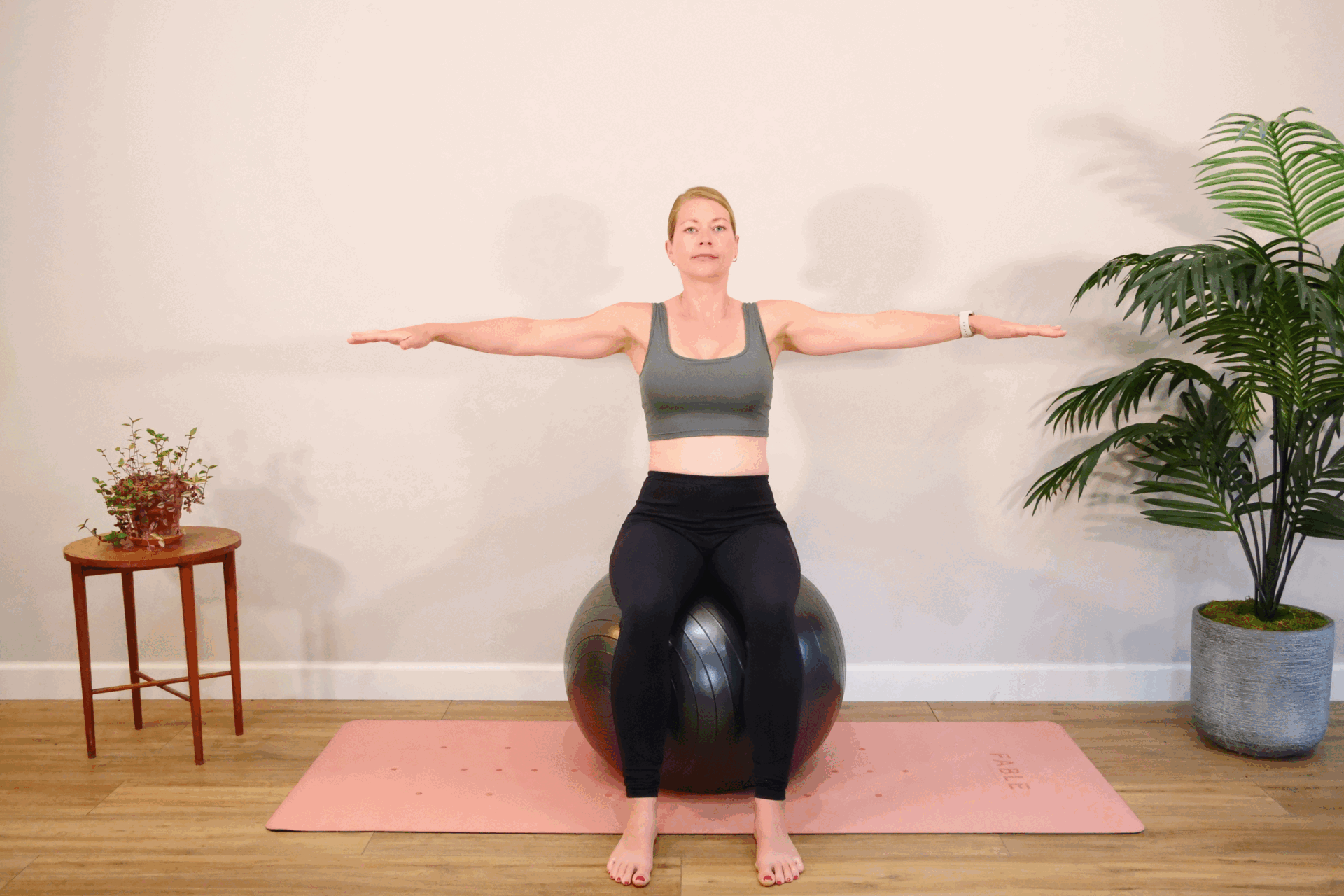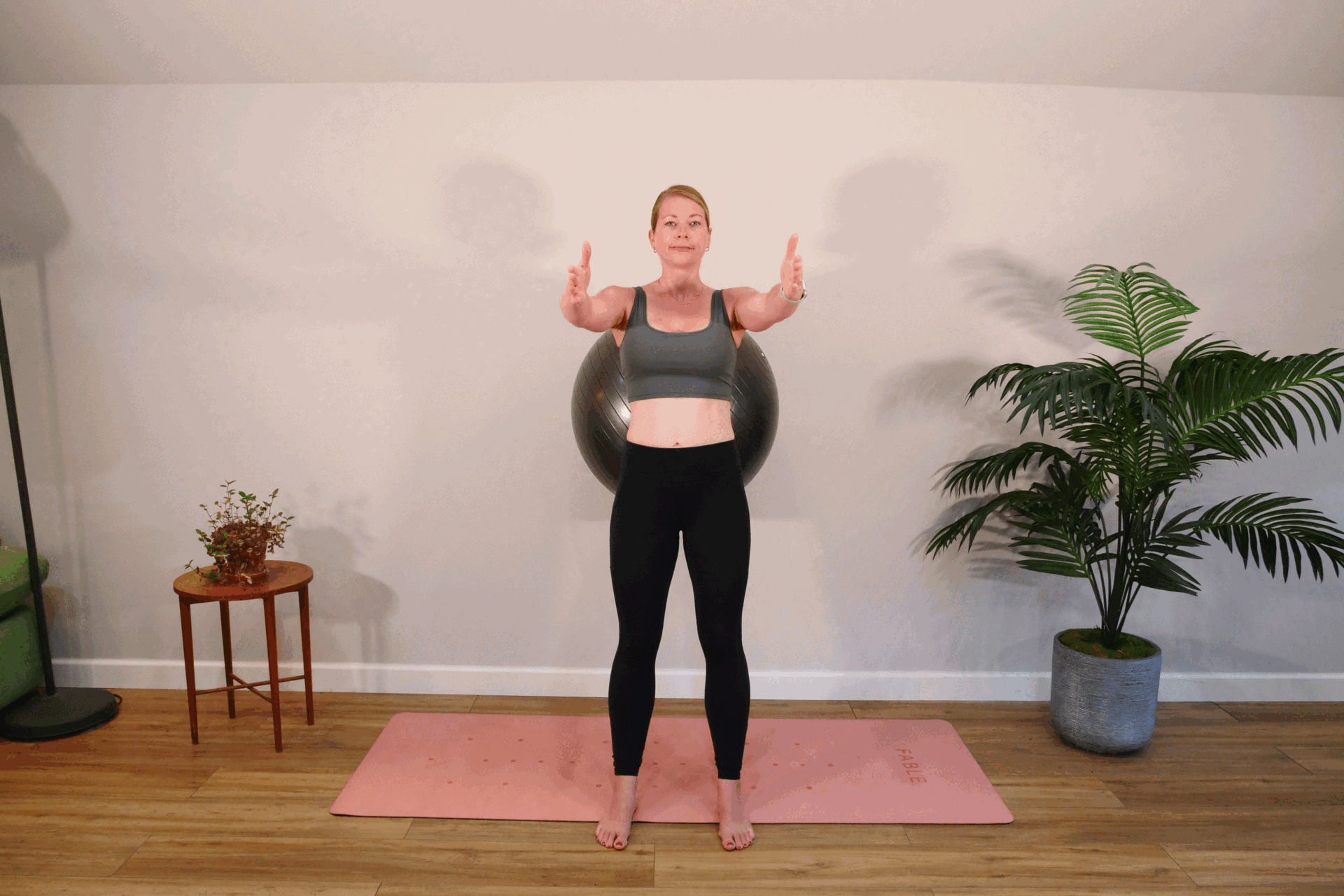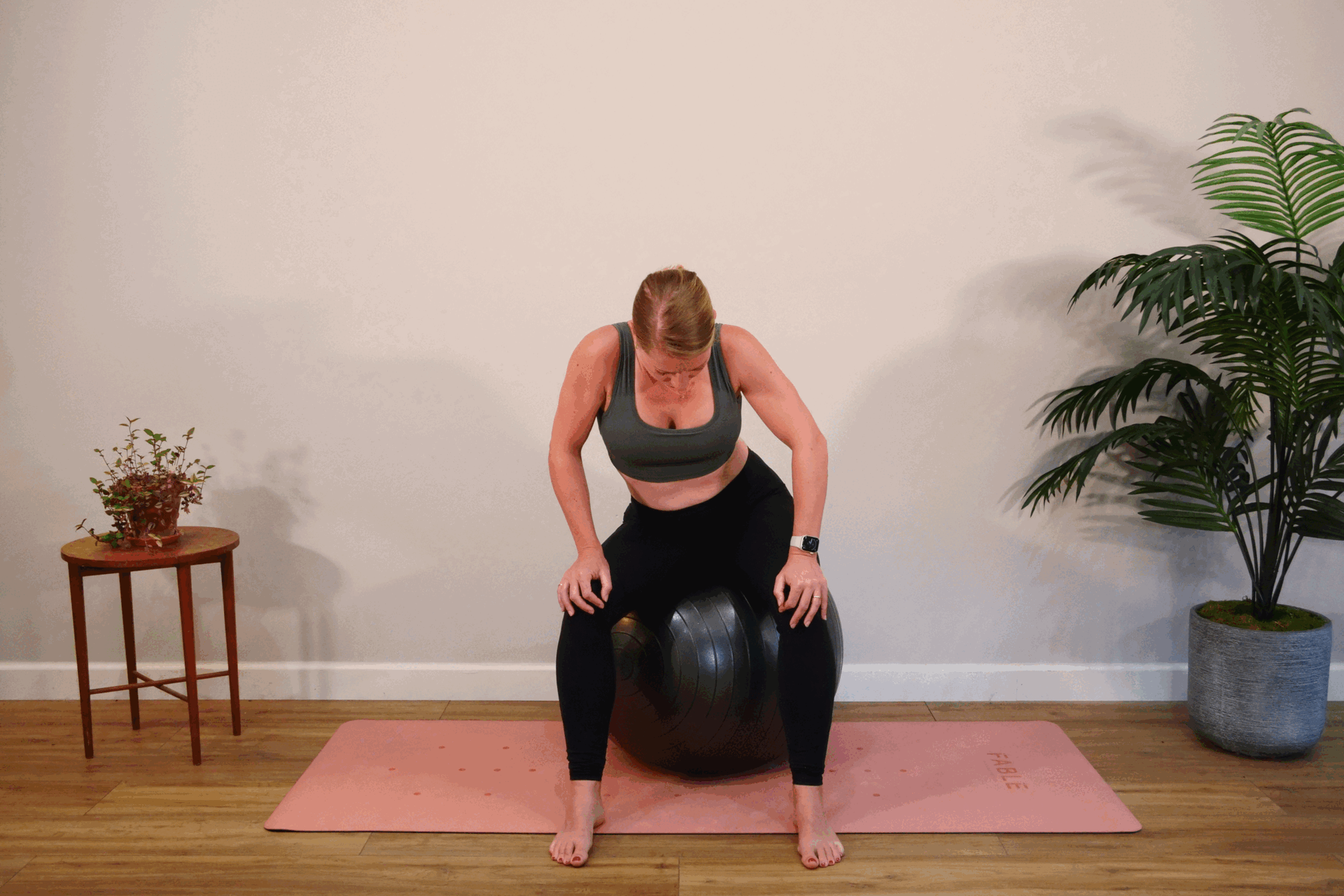Swiss ball exercises in pregnancy: 12 moves to try, and how to make them safe
A prenatal exercise experts reveals how to reap the benefits of using a Swiss ball during pregnancy


Whether you call them gym balls, pregnancy balls or exercise balls, there’s no doubting that a Swiss ball can be a useful prop when you’re expecting.
“Regular movement in pregnancy is really important, and Swiss balls are a great mobility tool,” says Michelle Norton-Hughes, a physiotherapist specialising in women’s health and the founder of FlyMama. Key benefits include helping to maintain core strength, alleviating backache and relieving pressure on your pelvis.
What’s more, research suggests that regular Swiss ball exercises during pregnancy can also reduce the risk of caesarean section. A 2015 study published in the Journal of Midwifery and Maternal Health concluded that performing birth ball exercises for 4-6 weeks at the end of pregnancy could increase the rate of vaginal delivery.
They can be a useful prop during labour, too. One study, published in the January 2024 issue of the Journal of Physiotherapy, found that performing active pelvic movements on a Swiss ball during labour reduced the duration of labour, pain intensity, and the fatigue and anxiety experienced by birthing mothers.
Below we’ve suggested 12 expert-approved moves to try throughout the course of your pregnancy and labour. However, you can also get the benefits by introducing a ball to your day-to-day life, too. “They can be great to sit on for a bit in the evening when you're watching TV,” suggests Dr Aarthi Sinha, a GP at Church Crescent Medical.
5 benefits of using a Swiss Ball in pregnancy and labour
- 1. Promotes mobility - ‘It’s really important to keep the joints supple and moving during pregnancy,” says Michelle. “The wonderful thing about a Swiss ball is it means that you can move your hips, back and bottom in a way that you might not naturally do otherwise.”
- 2. Improves balance and stability - Studies have shown that balance and postural stability are negatively impacted during pregnancy, largely due to shifts in the pelvis and a changing centre of gravity. One way to counteract this can be to work on core stability.
“When you use a Swiss ball, you need to engage all of the muscles in your core and back,” explains Dr Sinha. “With regular use you’ll gradually strengthen these muscles, which is helpful not just for pregnancy but also postpartum.” - 3. Helps alleviate backache - Backache in pregnancy is a common complaint. This is often caused by the weight of the growing bump causing an anterior (forward) tilt in the pelvis. This in turn causes the lower back to arch more, resulting in increased pressure – and ultimately aches and pains. Likewise, if you’re prone to sitting in a slumped sofa position, this can also lead to pain in the lower back. Sitting on a Swiss ball can help counteract these issues. “A gym ball forces you to sit on your ischial tuberosity [sitting bones],” says Michelle. “Anatomically you're spreading the load a lot more evenly, so you're less likely to get aches, pains and tightness.”
- 4. Relieves pressure on the pelvis - Women typically gain between 10kg and 12.5kg in weight over the course of their pregnancy, which puts increasing pressure on the pelvis. Performing Swiss ball exercises can help to temporarily relieve this pressure, particularly moves performed in a kneeling position.
“When you hug the ball on your knees and let your tummy drop down, it takes the weight of the baby and your tummy off of your pelvis,” shares Michelle. “It also means you don’t have to put pressure through your hands and wrists, which is great if you’re suffering with Carpal Tunnel Syndrome [a condition that affects around 60% of pregnant women, and is caused by a compression of nerves in the hand and wrist]. - 5. Promotes an active labour - An active labour – one in which you remain upright move around where possible – has many benefits, and a Swiss ball can help to achieve this. “The ball takes some of the weight of your body, and also allows you to move into different positions,” says Michelle.
So why’s it so beneficial? “When using a Swiss ball, you can naturally adopt lots of upright, forward and open positions,” says Pip Davies, a practising midwife and the founder of Midwife Pip. “This can be great for optimising not only the baby's position, but also the expansion of your pelvis.” She adds: “It's much better in terms of labour ergonomics than lying in bed or slouching in a chair.”
Safety considerations before you use a Swiss ball
Keeping yourself and your baby safe is of paramount importance when using an exercise ball in pregnancy. Here’s what to consider:
- Use the correct ball for you - Swiss balls come in different sizes, and the correct one for you will depend on your height. Midwife Pip offers the following guidelines: Up to 5’ 8”: use a 65cm Swiss ball / Over 5’ 8”: use a 75cm Swiss ball.
This will help ensure that your legs are in the right position – roughly at right angles, with your knees a little lower than your hips – when sitting on the ball. Also be sure to check the maximum weight of your ball before using it, although this should not be an issue if you choose a good-quality ball from a reputable brand. - Safe environment - Ensure the space where you plan to use your Swiss ball is safe, including: free of obstacles, a non-slip surface, away from sharp objects that could pierce the ball.
- Listen to your body - As with any movement or exercise (whether pregnant or otherwise), it’s important to tune in to how your body feels. “If any positions you adopt on the ball don't feel comfortable, then stop and change it up,” advises Midwife Pip. You should also avoid overexertion. Instead, stick to a moderate intensity when working out during pregnancy, as per NHS guidelines.
- Follow official guidelines - NHS guidelines also advise avoiding lying on your back for more than a few minutes, especially after 16 weeks, due to the increased pressure this can place on vital veins. This doesn’t mean you can’t perform moves with your Swiss ball that involve lying on your back, such as bridges done with your feet up on the ball. However, it is best to limit the time spent doing these moves, and to alternate with moves done in standing, kneeling or sitting.
Swiss ball exercises in pregnancy
Below you’ll find 12 Swiss ball moves to try – three for each trimester followed by three to prepare for labour and birth – shared exclusively with GoodtoKnow by Hollie Grant, a pre- and postnatal exercise expert and the founder of The Bump Plan.
Parenting advice, hot topics, best buys and family finance tips delivered straight to your inbox.
From improving pelvic stability to easing backache, these exercises will help you make the most of your pregnancy ball during pregnancy and the birth.
First trimester exercises
Ball Bridge
Benefits: Strengthens the glutes, hamstrings, and lower back, supporting pelvic stability.
How to do it:
- Lie on your back with your feet on top of the Swiss ball, knees bent, and arms by your sides.
- Engage your glutes and lift your hips toward the ceiling, creating a straight line from your shoulders to your knees.
- Hold the bridge position for a few seconds before lowering your hips back down.
- Repeat for 10-12 repetitions.

Side-Lying Leg Lifts with Ball
Benefits: Strengthens the inner and outer thighs, helping to support the pelvic area.
How to do it:
- Lie on your side with the Swiss ball between your feet.
- Support your head with one arm and place the other hand on the floor in front of you for balance.
- Engage your core and lift the ball a few inches off the ground using your legs.
- Hold briefly, then lower the ball back down.
- Repeat for 10-12 repetitions on each side.

Seated Ball Arm Raises
Benefits: Strengthens the shoulders and upper back, improving posture during pregnancy.
How to do it:
- Sit on the Swiss ball with your feet flat on the floor, hip-width apart.
- Hold a pair of dumbbells in your hands.
- Slowly raise your arms out to the sides until they reach shoulder height.
- Lower your arms back down with control.
- Repeat for 10-12 repetitions.

Second trimester exercises
Ball Leg Extensions
Benefits: Enhances balance and strengthens the quadriceps, important for supporting the growing bump.
How to do it:
- Sit on the Swiss ball with your feet flat on the floor, hip-width apart.
- Extend one leg straight out in front of you while maintaining balance.
- Hold for a few seconds, then lower the leg back down.
- Repeat with the other leg and alternate for 10-12 repetitions on each side.

Ball Pelvic Floor Exercises
Benefits: Strengthens the pelvic floor, crucial for labour and recovery.
How to do it:
- Sit on the Swiss ball with your feet flat on the floor, hip-width apart.
- Engage your pelvic floor muscles as if you’re stopping the flow of urine.
- Hold the contraction for a few seconds, then release.
- Repeat for 10-15 repetitions.

Seated Ball March
Benefits: Improves core stability and strengthens the hip flexors.
How to do it:
- Sit on the Swiss ball with your feet flat on the floor, hip-width apart.
- Engage your core and lift one foot off the floor, bringing your knee toward your chest.
- Lower the foot back down and repeat with the other leg.
- Alternate legs in a marching motion for 1-2 minutes.

Third trimester exercises
Pelvic Tilts on the Ball
Benefits: Strengthens the lower back and core, helping to reduce pregnancy back discomfort.
How to do it:
- Sit on the Swiss ball with your feet flat on the floor, hip-width apart.
- Place your hands on your hips for balance.
- Slowly tilt your pelvis forward, arching your lower back.
- Then, tilt your pelvis backward, tucking your tailbone under.
- Continue tilting back and forth in a controlled motion for 10-12 repetitions.

Seated Ball Circles
Benefits:
Improves pelvic mobility and core stability, helping to alleviate pelvic discomfort.
How to do it:
- Sit on the Swiss ball with your feet flat on the floor, hip-width apart.
- Place your hands on your hips and slowly rotate your hips in a circular motion.
- Perform 10 circles in one direction, then switch to the opposite direction.

Wall Squats with Ball
Benefits: Strengthens the legs and glutes, preparing the body for labour and the postnatal period.
How to do it:
- Place the Swiss ball between your lower back and a wall.
- Stand with your feet shoulder-width apart and step forward slightly.
- Slowly lower your body into a squat position, keeping your knees behind your toes.
- Hold for a few seconds, then push through your heels to return to standing.
- Repeat for 10-12 repetitions.

Swiss ball exercises for labour
Here are Hollie's suggestions for positions on the ball that you may find useful in the birthing room.
Supported Squat with Ball
Benefits: Opens the pelvis and encourages the baby to descend, easing labour pain.
How to do it:

- Stand with the Swiss ball placed behind your lower back against a wall.
- Slowly lower into a squat, allowing the ball to roll up your back for support.
- Hold the squat position for as long as comfortable, using it to ease labour contractions.
Forward Leaning Position on Ball
Benefits: Takes pressure off the lower back and pelvis, helping to manage labour pain
How to do it:
- Kneel on the floor with the Swiss ball in front of you.
- Lean forward, draping your upper body over the ball and relaxing your arms and shoulders.
- Rock your hips side to side or back and forth to ease contractions.

Ball Rocking
Benefits: Promotes pelvic relaxation and helps position the baby for birth.
How to do it:
- Sit on the Swiss ball with your feet wide apart for stability.
- Gently rock your hips side to side or in a circular motion.
- Use this movement to ease labour discomfort and help the baby into an optimal position.

FAQs on exercising with a Swiss Ball in pregnancy
How many weeks pregnant can you use a Swiss ball?
“You can use a Swiss ball anytime during pregnancy, from trimester one to trimester three, and throughout all stages of labour,” says Midwife Pip.
If you’re already nearing the end of your pregnancy and haven’t done any ball exercises so far, don’t worry – it’s never too late to reap the benefits. Bear in mind the study mentioned in the introduction of this article, which showed that performing birth ball exercises for 4-6 weeks at the end of pregnancy could increase the rate of vaginal delivery.
Can bouncing on a ball induce labour or break your waters?
Bouncing on a ball will not induce early labour or cause waters to break, Pip confirms. She adds: “When in labour itself, it can be a great way of encouraging your baby into an optimal position.”
Is it good to sit on an exercise ball when pregnant?
“I absolutely loved sitting on my Swiss ball when I was pregnant,” mum-of-one Annalise Beech tells GoodtoKnow. “As my pregnancy progressed, I loved the mobility it allowed me to bring to my hip flexors, and sitting on it also helped me to feel lighter somehow.
“I also incorporated it into my pregnancy workouts, and particularly likely lying with my arms over the ball in a kneeling position. This helped to momentarily take the pressure off my back, which was a godsend in those final few weeks.”
The information on GoodTo.com does not constitute medical or other health advice or diagnosis and should not be used as such. Although GoodtoKnow consults a range of medical experts to create and fact-check content, this information is for general purposes only and does not take the place of medical advice. Always seek the guidance of a qualified health professional or seek urgent medical attention if needed.
Experts in this article:

Michelle is a physiotherapist specialising in women's pelvic health with over 20 years of experience. She is the co-founder of FlyMama, a platform that offers pregnancy and postnatal support, as well as perinatal trauma and loss support. Michelle is also a qualified Mummy MOT practitioner, and has previously been invited to speak at the Pelvic and Obstetric Gynaecology Physiotherapy Society's annual conference.

Hollie Grant is the founder of Pilates PT and creator of pre and postnatal exercise platform The Bump Plan. As a Tatler award-winning personal trainer, highly experienced Pilates expert and advanced prenatal specialist, Hollie is passionate about encouraging women to think of their bodies not by dress size, but by its function, performance and capabilities. After training with STOTT and working with over 40,000 women across the globe for 10 years, Hollie now runs a successful fitness brand, including a personal training studio in London, two online memberships (Pilates On Demand and The Bump Plan) and is host of the Bun in the Oven podcast. Hollie’s mission is to empower, educate and motivate you to become the fittest and healthiest you can be.

Pip currently works as a delivery suite sister and a specialist pelvic health midwife, and also offers pregnancy and postnatal support services via her Midwife Pip platform. Her qualifications include a first class BSc in Midwifery and a KGH Hypnobirthing Diploma. She also holds a pre and postnatal exercise qualification and is a certified Mummy MOT practitioner. She is the author of Midwife Pip’s Guide to a Positive Birth (£16.99, Amazon) and the host of The Midwife Pip Podcast, where she discusses all things pregnancy and postpartum.

Dr Aarthi has been practising as a GP since 2014, mostly as a senior partner in practice. She completed her medical training at Guy’s and St Thomas’ Hospital Trust, part of King’s College London. She undertook further medical experience around the UK before settling in North London, where she completed my GP training. It is here that she set up her own practice, Church Crescent Medical. In addition to her medical degree, she also has a Bachelor's degree in Radiological Sciences and several diplomas in gynaecology, sexual health and occupational medicine.

Stephanie is former Acting Editor and Content Director at GoodToKnow. She is also mum to son Woody (don't worry, they don't share a surname!), who was born in November 2021. As a journalist, Stephanie has over 17 years' of experience, and has worked as a digital editor and writer for brands including Stylist, Fit&Well, MSN and Woman&Home.